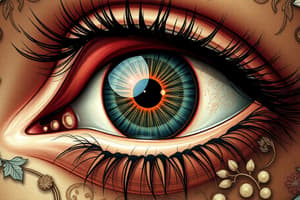Podcast
Questions and Answers
What is entropion?
What is entropion?
Inversion of the eyelid margin towards the globe
Which type of entropion is more common in the elderly?
Which type of entropion is more common in the elderly?
- Spastic Entropion
- Cicatricial Entropion
- Involutional Entropion (correct)
- Congenital Entropion
Congenital entropion is a common condition.
Congenital entropion is a common condition.
False (B)
What causes involutional entropion?
What causes involutional entropion?
Cicatricial entropion is caused by severe scarring of the ________ conjunctiva.
Cicatricial entropion is caused by severe scarring of the ________ conjunctiva.
Which of the following is a common cause of cicatricial entropion? (Select all that apply)
Which of the following is a common cause of cicatricial entropion? (Select all that apply)
What is a common symptom of entropion?
What is a common symptom of entropion?
What does 'FBS' stand for in ocular symptoms?
What does 'FBS' stand for in ocular symptoms?
Which type of entropion is characterized by a fold of skin pushing the eyelid margin inward?
Which type of entropion is characterized by a fold of skin pushing the eyelid margin inward?
Flashcards are hidden until you start studying
Study Notes
Eyelid Positional Issues
- A patient presented with constant tearing mainly in the left eye (OS)
- The patient was an 88-year-old male
- The patient had occasional foreign body sensation in the left eye (OS) more than in the right eye (OD)
- The patient's visual acuity was 20/20 OD, 20/25 OS, and 20/20 OU
- The patient's case is an example of eyelid positional problems
- Eyelid positional problems can lead to epiphora and foreign body sensation
Entropion and Ectropion
- Entropion**:** Inversion of the eyelid margin towards the globe
- Entropion is more common in the lower eyelid (LL)
- Entropion can be unilateral or bilateral
- Entropion is more common in the elderly
- Entropion signs include:
- Rolled-in lid
- Pseudo-trichiasis (eyelashes rubbing against the cornea)
- Hyperemia (redness)
- Corneal staining (exposure keratopathy)
- Secondary issues: pannus (abnormal tissue growth on the cornea), corneal scarring, infection, and ulceration
- Entropion symptoms: Foreign body sensation (FBS) and epiphora (excessive tearing)
- Ectropion:** Eversion of the eyelid margin away from the globe
- Entropion is less common than ectropion
Types of Entropion
- Involutional Entropion:** Occurs more commonly in elderly populations
- Due to a degeneration of elastic and fibrous tissues within the eyelid
- Orbital tissue atrophy allowing the globe to move posteriorly (relative enophthalmos)
- Increased horizontal lid laxity, decreased vertical lid stability, increased orbital septum laxity
- Congenital Entropion
- Rare
- Primary: Abnormal development of tarsus, orbicularis, or other musculature
- Secondary: Mechanical (anophthalmos, microphthalmos)
- Epiblepharon (mild entropion in young children):
- Characterized by a fold of skin overlapping the eyelid margin
- Pushing the eyelid margin inward
- Improves with age
- Cicatricial Entropion
- Severe scarring of the palpebral conjunctiva pulls the lid margin towards the globe
- Common causes:
- Cicatrizing conjunctivitis
- Trachoma (bacterial infection)
- Trauma
- Chemical injuries (acid or alkali burns)
- Inflammatory conditions (Stevens-Johnson syndrome, ocular pemphigoid)
- Spastic Entropion
- Occurs secondarily to neurologic problems (Bell's palsy)
- Often temporary
Types of Ectropion
- Involutional Ectropion
- Common in the elderly
- Due to degeneration of elastic and fibrous tissues within the eyelid
- Characterized by:
- Increased horizontal lid laxity
- Decreased vertical lid stability
- Increased orbital septum laxity
- Muscle weakness
- Mechanical Ectropion
- External force (tumor, trauma, eyelid)
- Causes eversion
- Cicatricial Ectropion
- Scarring of the eyelid
- Due to:
- Chemical burns
- Trauma
- Infection
- Paralytic Ectropion
- Nerve paralysis (facial nerve)
- Causes weakness of the orbicularis oculi muscle ( eyelid closure muscle)
- Usually temporary
Studying That Suits You
Use AI to generate personalized quizzes and flashcards to suit your learning preferences.




